-
Posts
19 -
Joined
-
Last visited
Content Type
Profiles
Forums
Store
Help Articles
Posts posted by Tomek
-
-
I'm not sure how they did it but this definately gives the best effects I've ever tried - http://perlagesystems.com/perlini/
The carbonated cocktail/drink was sparkling and sharp like champagne.
They say that they use beverage grade CO2 whatever that is.
-
Did you visit places like:
U Kucharzy
Gar
Polka
Ale Gloria
while you were here ?
-
Did your friend use "straight" cointreau for that ? I've had problems with getting 40% alcohol to form spheres ? I did some reading and thought that indeed tooo much alcohol doesn't work. From my experience around 20 to maximum 24% alcohol seems to work.
Can somebody shed some light on this ? I'm using the Biozoon alginate and calcium.
I also wanted to check on another thing as well.
I made Chambord liqueur caviar recently which was put in sparkling wine.
After a while the contents of the caviar seemed to be displaced by the sparkling wine. Is that just some sort of osmosis type process?
-
I'm still getting my head round the German instructions which are not as easy as I thought. Even a German I met at the weekend had trouble to explain it to me. However the 2 ingredients that I mentioned are:
Riboflavin (E101) and Beta-Carotin (E160a)
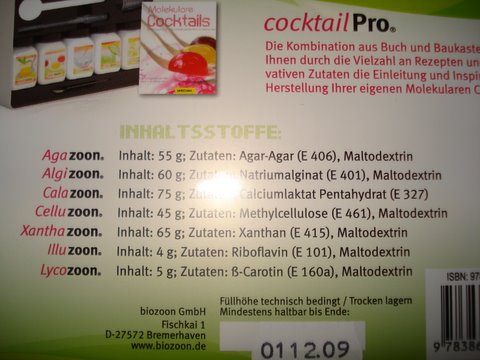
The Riboflavin is supposed to make drinks "glow in UV light". Unfortunately I don't have a UV at home to see what the effects are.
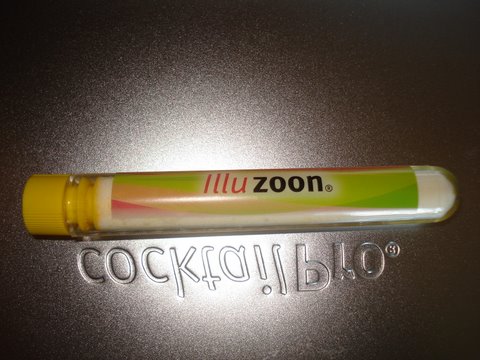
The Carotin is meant to give "deeper colour" to drinks
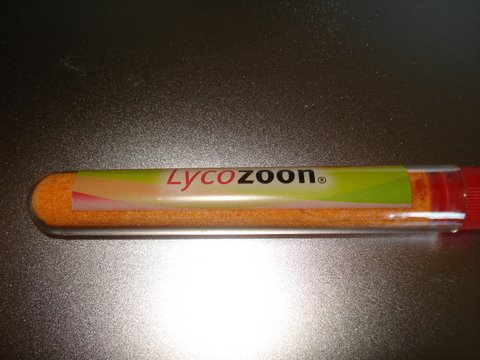
The other ingredients are Agar Agar, Sodium Alginate, Calcium Chloride, Methylcellulose and Xanthan.
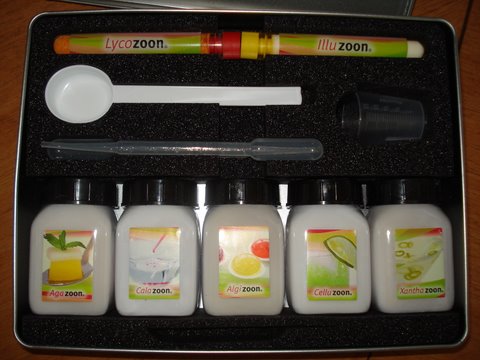
The set comes with a metal measuring spoon, 2 3ml dropper pipettes, a measuring cup up to 25ml, a plastic spoon and book - instructions and recipes.
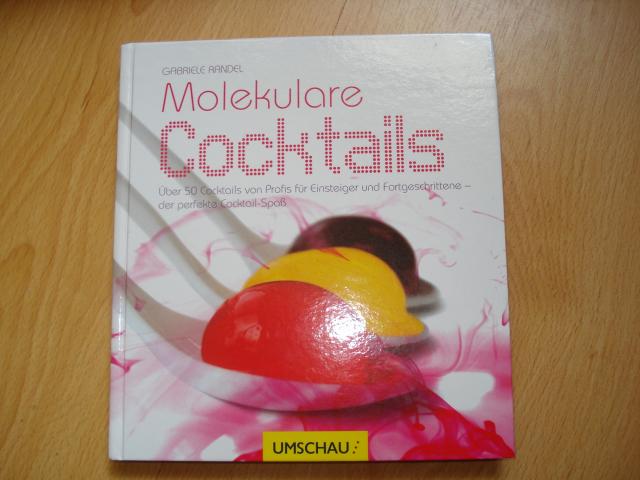
As soon as I get my head round the Geman obstacle and have any results I will definately report back. I'm a complete novice to this game.

The one thing that struck me so far with all the ingredients of the set is that they seem to be dosed with the metal spoon that comes with the set. No weighing involved i.e. Dissolve 4 spoons of alginate in 120ml of water. Then mix 20ml of the mixture with 40ml of cocktail. 4 spoons of Calcium Chloride in 130ml of water to make the bath.
That is if my guesses of the German are correct.
-
I will definately do that when I give them a go over the coming weekend. I might need some help from a German speaker

-
I received my Biozoon Cocktail Pro set today. I was wondering if anyone has bought or used this set ? http://www.biozoon.de/shop/product_info.php?info=p28_.html
There's a great book that comes with the set with around 50 recipes. Unfortunately it's in German so I have to start learning it soon.
However the set looks very professional and is intended specially for cocktails. It also has 2 interesting ingredients that I never came across before. One is some sort of dye and the other something that makes drinks glow in UV light as far as I can tell.
-
Nice. Thanks for that. I would have thought that for 1450 USD they atleast wouldn't make basic spelling mistakes on the labels i.e. could afford to have a proofreader

-
2 out of 4 of us have got rejections so far

-
Wow thanks for the explanation slkinsey.
The rectified spirit- that's how it's labeled on the bottles here - I would say is very clean and neutral. If you dilute it with water it's very drinkable. I'm not an expert but I know that from experience in a way. My dad uses it every Christmas to make a traditional hot drink that we always have at Christmas dinner with honey, lemon, cloves and cinnamon. Of course it's diluted down with water as well - but always served very hot. Very good for cold winters in Poland

Eje here are two recipes from my dads family liqueur book that was kind of passed down to him from my grandfather. He has quite a few but here are two he gave me today.
He always makes them in 5 litre bottles/jars. Its a bottle that's really wide at the bottom and gets narrow at the top with thatched cane around 2/3 of the bottle.
Wild or blackcherries
2kg blackcheries
400g natural honey
3/4 l of rectified spirit (90 ABV I think)
1 1/2 l of vodka
Put them together for 6 weeks and then bottle and leave for as long as desired. Obviously the longer the better.
Funnily enough he doesn't filter it when he puts it in bottles but rather "takes it" off the top from the big container using a rubber tube. A bit like siphoning it. I hope my English is understandable

The second one is the Walnut one made with green walnuts. He stressed that you have to make sure that the shell hasn't started to form yet. He makes this one around early july here.
So here goes:
24 green walnuts cut into quarters
15 prunes
i stick of cinnamon
1 stick of vanilla
1/2 kg of brown sugar
One star anise
Some unground pepper corns
2 l of vodka
1/2 l of rectified spirits
Put it in the same kind of 5 l container.
After 2 weeks he ads half a lemon that was soaked in vodka for 1 day.
This is then left until the end of September until it's bottled.
Have you tried to make one with Rowan - http://en.wikipedia.org/wiki/Sorbus_aucuparia ? It's very popular here.
-
Hi Everyone,
I wanted to try to get some information about something that is very traditional here in Poland (sorry about the long post).
We have a tradition here of making infusions or what the dictionary translates into English as "tinctures". The basic idea is pretty much standard - take something from nature and put it in vodka or usually the recipes specify "rectified spirit" - the really potent 90 ABV flavourless alcohol and sugar. They are usually left to mature for months and if possible even years and almost always dilluted with water at some point in the process.
Making these "nalewka" as they are called is a tradition in our country that goes back centuries and autumn is the time to make them. Some of them are considered to have medicinal properties (like the gralic ones).
My dad always makes one with black cherries or wild cheries and wallnuts using the unripe nuts in their green shells.
And this is pretty much my question - has anyone tried to make infusions/tinctures with things like:
Rowan - http://en.wikipedia.org/wiki/Sorbus_aucuparia
Wild rose berries or fruits
Blackberries
Prunes
What is the difference between an infusion and a tincture ?
Is it just the amount of time that the flavouring part is left in the alcohol ?
Can anyone also tell me if there is a difference if I use vodka or rectified spirits from a chemical reaction side?
Any help will be greatly appreciated.
-
Hi Everyone,
I wanted to try to get some information about something that is very traditional here in Poland (sorry about the long post).
We have a tradition here of making infusions or what the dictionary translates into English as "tinctures". The basic idea is pretty much standard - take something from nature and put it in vodka or usually the recipes specify "rectified spirit" - the really potent 90 ABV flavourless alcohol and sugar. They are usually left to mature for months and if possible even years and almost always dilluted with water at some point in the process.
Making these "nalewka" as they are called is a tradition in our country that goes back centuries and autumn is the time to make them. Some of them are considered to have medicinal properties (like the gralic ones).
My dad always makes one with black cherries or wild cheries and wallnuts using the unripe nuts in their green shells.
And this is pretty much my question - has anyone tried to make infusions/tinctures with things like:
Rowan - http://en.wikipedia.org/wiki/Sorbus_aucuparia
Wild rose berries or fruits
Quince (I think I saw one in the previous posts)
Blackberries
Prunes
Anna N - this is a recipe I'm going to try today. I don't know if it will help to achieve what you want to make:
100g Caraway Seeds
3/4 L of Rectified Spirit
1/4 L of Water
Orange peel from 1/4 Orange
300 g of Sugar
The recipe is something like this:
Crush the caraway seeds and put in a jar with the spirit, water and orange peel for 2 months.
After this time add the sugar and leave for 2 weeks. Then pass through a seive/cloth to clear. Bottle and leave for another 2 months.
What is the difference between an infusion and a tincture ?
Is it just the amount of time that the flavouring part is left in the alcohol ?
Can anyone also tell me if there is a difference if I use vodka or rectified spirits from a chemical reaction side?
Any help will be greatly appreciated.
-
Hi Larkien,
Being Polish and living here below is a translation of one recipe I found. By the way you put me onto something I'd never heard of or drank previously so respect to you

Apparently Warzonka comes from the Silesia (Slask) region of Poland and should be drank hot. In the silesian dialect "warzyc" means "to cook". All the recipes I checked are pretty much identical so here goes:
Miod pszczeli 3 lyzki - 3 spoons of honey
Cytryna 1 szt. - 1 lemon
Spirytus 300 g. - 300g of i think what you call everclear - very high content alcohol with abv. of 90 or 180 proof in american terms.
Cukier 10-15 dag. - Sugar 100-150 grams
Woda 2 szklanki - 2 glasses of water
Cynamon,gozdziki - cinammon and cloves
And the recipe is more or less like this:
From the sugar make a light yellow coloured caramel, add the lemon juice, honey and blended herbs according to taste together with the water. Combine everything very well until the caramel has melted (or dissolved), boil and then remove from the heat. In an enamelled pan with the simmering mixture VERY carefully add the everclear and stir witha wooden spoon.
Serve hot
Przepis:
Z cukru sporzadzic karmel o jasnozlotej barwie,dodac do niego sok z cytryny,miod,zmielone korzenie wedlug smaku oraz wode.Wszystko dokladnie wymieszac do chwili rozpuszczenia sie karmelu,zagotowac i zdjac z ognia.Do wrzacego w emaliowanym garnku plynu bardzo ostroznie wlac spirytus,zamieszac czysta drewniana lyzka.Podawac na goraco.
I hope that hepls you if you have any other Polish recipes you need help with then just give me a shout

I must say that it seems very similar to Krupnik which my father always makes on Christmas eve.
Tomek
-
Maybe I am being too pick by trying to get nice clear ice at home. The fact is that distilled water isn't very nice for drinks in my opinion. But clear cubes do look more appealling in an old fashioned somehow
 Maybe it's time to start saving for an ice machine.....
Maybe it's time to start saving for an ice machine..... -
So I tried one of the suggestions that was put forward here. I bought myself some distilled water which is supposed to be VERY pure. The cubes came out a bit better but still not that transparent. I guess I'll just have to keep trying.

-
Wow I love cardamom especially with pineapple.
Can you let me know where I might be able to get this liquor by mailorder ?
-
Thanks for all the tips I must say however that:
1. I tried the hot water version
2. I've used mineral water and boiled water
3. I've turned my freezer downs as far as possible
And the results still aren't satisfactory.
I haven't tried distilled water as yet but will do in the near future and I definitely can't afford an ice machine at the moment.
The bottom freezing idea seems interesting but my home fridge/freezer has the freezing element at the top.
I'll keep trying I guess until I finally get that all important clear cube at home
-
I loved U-F-O. The food and drinks were great. Didn't eat much at paparazzi but I think we drank most of the cocktails on the menu.
Hoping to go back in april/may for stan's japanese cocktails workshop.
-
Hi All,
I was wondering if anyone has any home tips for getting ice cubes without those annoying white bits in the middle.
I've recently managed to get some of those IKEA molds here in Poland but I'm really dissapointed with those white areas in the cubes.
From what I've managed to read here and there it seems that the way to get lovely transparent cubes is in a machine where the water "runs through" the cube elements.
Any help on this would be greatly appreciated



Carbonating Spirits
in Spirits & Cocktails
Posted
I guess someone from Vessel would be in a good position to tell more about it. I just had the opportunity of playing with it during a workshop with Jamie Boudreau in Prague in January 2009 if memory serves me correctly.You can see what it looks like here - http://alkoteka.wordpress.com/2008/12/10/w...-boudreau-cz-2/